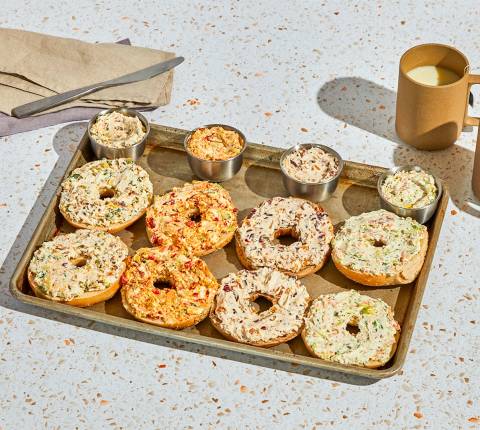Fusion. We all know it, but for a while there, it became a bit of a dirty word in the culinary world. The idea of uniting food from two cultures has been around for a long time (spaghetti, after all, could never have come to be without the Chinese noodle). But during the fusion boom in the ’80s and ’90s, flavor combinations sometimes got a little out of hand—yielding less-than-appetizing results. Remember the smoked salmon pizza? All those menus that were half sushi and half pasta? Or maybe the dainty soy-sauced tuna tartare on endive leaves? That old fusion tried too hard to be different. Does anyone still want to eat neon-green wasabi mashed potatoes?
But in 2022, fusion is back, and it means something else entirely. There's a class of young chefs that are drawing from their stories either influences from their heritage as first- or second-generation Americans, formative travels they’ve taken, or their training. No more cheeseburger egg rolls. Instead, these chefs are bringing what makes them, them to the table.
Restaurants are popping up all over the country that are doing this new “fusion.” There’s Thai Diner in New York, where husband-and-wife team Ann Redding and Matt Danzer are offering up Thai disco fries smothered in massaman curry, and stuffed cabbage tom khaa, an Eastern European dish served in a very Thai lime-y coconut sauce. Just down the street at Kimika, chef Christine Lau is blending Japanese and Italian, and a little farther in on the Lower East Side at Golden Diner, Samuel Yoo’s food incorporates influences from countries ranging from Mexico to Korea.
“If you think purely of the definition of fusion, which is ‘the process or result of joining two or more things together to form a single entity,’ we are most certainly a fusion restaurant serving fusion cuisine, drawing from cuisines that I grew up eating and eventually cooking as a chef born and raised in NYC,” Yoo says. “It's inextricable to who I am as much as my DNA is. At the end of the day, labels aside, we're just trying to make food that's delicious and accessible in a thoughtful and meaningful way.”
When Yoo develops new dishes, he always first evaluates why he should put them on the menu. “Is it summer and the market is filled with beautiful greens we can showcase for a crisp salad? Can we find ways to share our heritage through dishes like jajangmyeon, a comfort food that's also eaten as a single person on romantic holidays? Can we infuse ourselves, as first-gen immigrants of New York, with childhood memories something that would resonate with our neighborhood? That’s how we come up with something entirely new, like Jamaican beef ddukbboki.”
For fusion outside of New York, look to Badmaash in L.A., where the Mahendro family is melding Indian flavors with American classics in dishes such as Badmaash fried chicken and masala potato fries. In Houston it’s at Le Colonial, where restaurateurs Rick Wahlstedt and Joe King are drawing from Southeast Asian influences but using local Texan ingredients like Bella Verdi Farms greens and Texas pecans in their namesake Le Colonial Salat.
In 2022, fusion is a lot of things. Vibrant food that’s exciting and more approachable. There’s often a youthfulness, maybe tied to nostalgia of a grandparent’s kitchen or a life-changing papaya salad on a backpacking trip. A locavore spirit makes itself known with ingredients that are more seasonal or market-driven. Fusion can be more upscale, like at the Korean American steakhouse Cote, but also casual, like at KoJa Kitchen, with its mash-up tacos, and Bao'd Up, with its inventive bao. It has very little in common with that tweezer-y food that dominated fine dining in decades past.
Fusion is quintessentially American: fusing old and new, near and far, and making something totally original. Bring on the Vietnamese Caesar Salads and Crispy Rice Cake Lasagnas—we’re all for it.





